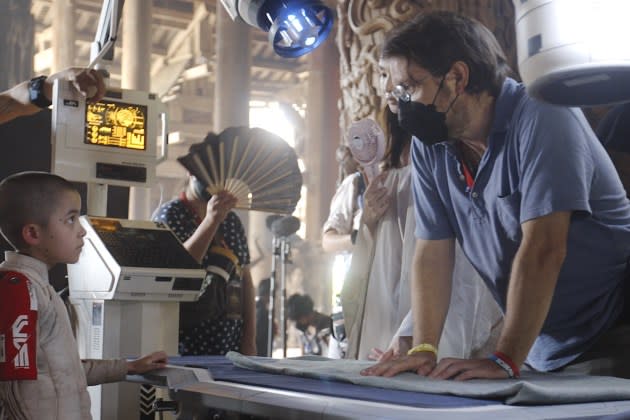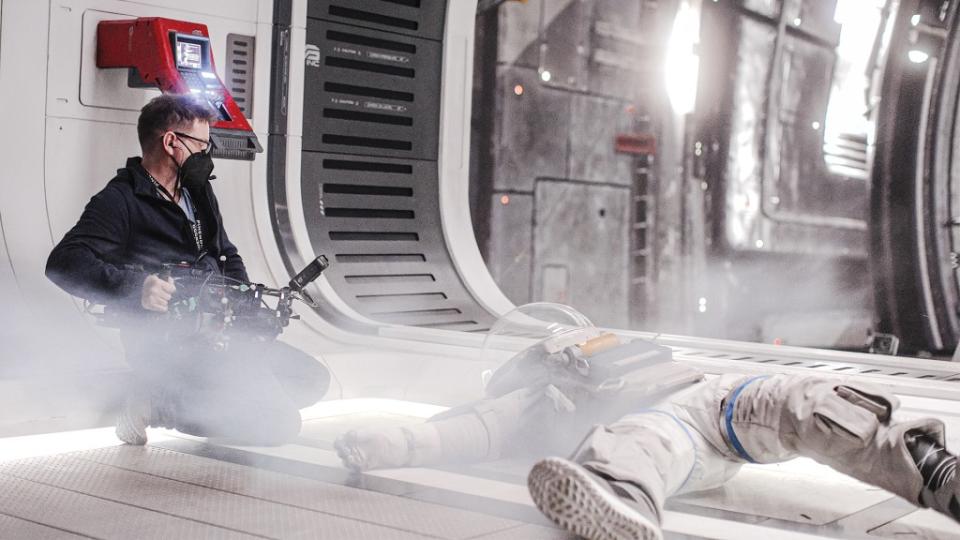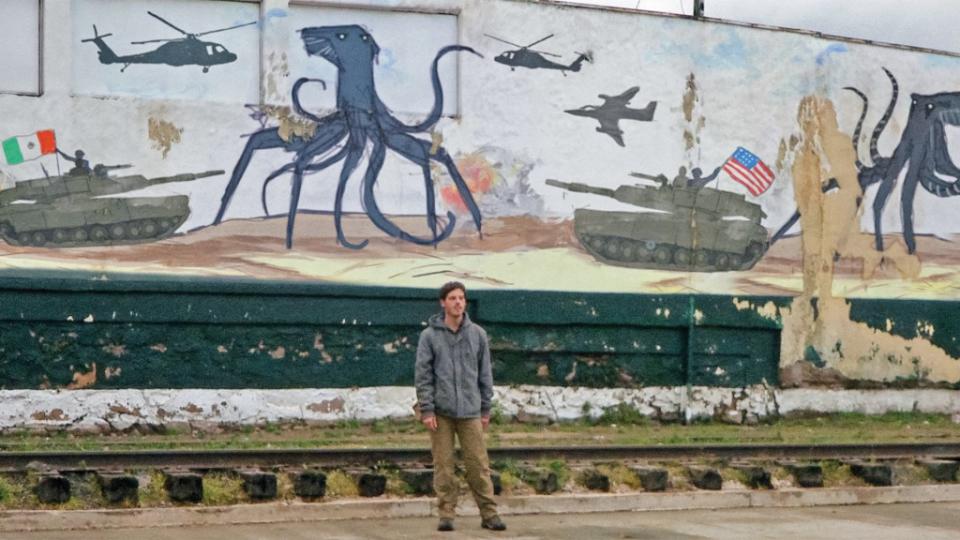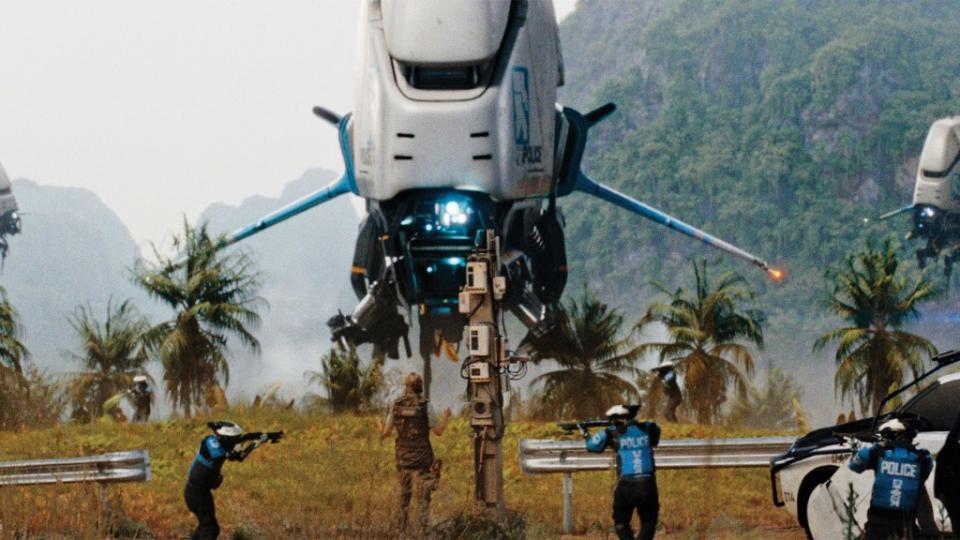After ‘Rogue One’ and ‘Godzilla,’ Gareth Edwards Wants to Revolutionize How Studio Films Get Made With ‘The Creator’

When Gareth Edwards directed his first movie, the 2010 indie “Monsters,” it could scarcely have been a more DIY endeavor. He had less than $500,000 to tell an intimate story about two Americans contending with giant aliens rampaging through Mexico, so his crew consisted of just his actors (Scoot McNairy and Whitney Able), a sound tech, a line producer, a translator and a driver. Edwards operated the camera, grabbing footage guerrilla style whenever they came upon a compelling location while traveling through Central America. Then the young director created all 250 visual effects shots for the film himself, alone in his flat.
Thirteen years later, Edwards’ latest film, “The Creator,” is in so many ways the opposite of “Monsters.” The budget is $80 million. 20th Century Studios is distributing it worldwide. (New Regency and Entertainment One co-financed.) Dozens of actors — including John David Washington, Allison Janney and Ken Watanabe — filmed across Nepal, Thailand, Vietnam, Cambodia, Indonesia and Japan to portray a sweeping, existential conflict between humanity and artificial intelligence, while Industrial Light & Magic marshaled thousands of extensive VFX shots.
More from Variety
And yet, if you’d stumbled onto the set of “The Creator,” chances are it would’ve looked like another scrappy, DIY indie: just the actors, an assistant director, a boom operator, a lighting technician, and Edwards, once again manning the camera.
“There was an army of people, but they had to be completely out of sight,” Edwards says. “If you stood where the actors were and looked around, you shouldn’t see the crew at all.”
“The Creator” is a gargantuan experience, packed with violence, intensity and the kind of dramatic, intricately detailed world-building that audiences expect from films of this scope. But it also cost a fraction of nearly every other giant studio film like it this year, several of which ballooned to $300 million and beyond. After directing two equally massive studio tentpoles with far greater budgets following “Monsters” — 2014’s “Godzilla” and 2016’s “Rogue One: A Star Wars Story” — Edwards became convinced that there had to be a better, leaner way to make studio movies on a blockbuster scale.

“It made total sense to have 300 people surrounding you when you’ve got tanks and dozens of soldiers running across the Golden Gate Bridge as monsters are attacking,” Edwards says. “It didn’t make as much sense to have 300 people around you when you’re filming in a room with two actors talking to each other. That’s the bit I wanted to try to do differently.”
Working with cinematographers Greig Fraser (“Rogue One,” “Dune”) and Oren Soffer (“Action Royale”) — and leaning on a new wave of affordable, lightweight filmmaking technology — Edwards stripped everything down to its essentials to inject more spontaneity and creative freedom into a process that felt needlessly rigid.
“Throughout ‘Rogue One,’ we were always talking about his dream project,” says Fraser. “Basically, his perfect world would be him, a couple of actors, and that’s it.”
By contrast, Edwards describes studio filmmaking as “an unstoppable machine” relentlessly driving toward a release date. “You have to work at the pace that the machine is working at. There are times where you wish you could just stop everything and take a moment to just figure something out. And you can’t.” He grimaces. “It’s hard to talk about this in a way that doesn’t sound like I’m not grateful for getting the opportunity.”
Indeed, whenever the soft-spoken 48-year-old British expat begins to speak his mind about the way Hollywood operates, he follows up with some form of apology for his seeming lack of gratitude. Even during our interview, he’s almost embarrassed about spending other people’s money, offering multiple times to pay the check during our dinner at an L.A. steakhouse in late August. Once I make it clear that Variety is picking up the tab, he orders the least-expensive fillet on the menu.
Edwards’ reflexive self-effacement comes from a particularly hard-won path to directing. After graduating from film school in the mid-’90s, he found employment as a visual effects artist, largely for BBC docuseries, working out of his studio apartment, at first using pirated software because he “couldn’t afford the real stuff.”
“I was, like, the cheapest person that BBC could use for visual effects — like, five times cheaper than the nearest person,” he says. “So I got loads and loads of phone calls all the time.”

The work was so steady that for the next 10 years, Edwards kept deferring his plan to become a director — though he did score gigs directing BBC docuseries like “Perfect Disaster” by promising to do the VFX work for free. By the time he was 33, however, “the fear of failure was less than the fear of never having tried,” he says.
“I felt like I’d wasted 10 years of my life,” he adds with a deep sigh. “But when I look back on it now, I guess the thing I didn’t anticipate was that if I got this opportunity to do these big, blockbuster-y films, a lot of that process was going to be dealing with visual effects. And that has ended up being quite useful.”
Less than a year after “Monsters” debuted at SXSW in 2010, Edwards landed the dream gig to direct “Godzilla.” But the adjustment proved about as daunting as facing down a 350-foot, fire-breathing kaiju. On his first day on set, he says, “I walked past row after row after row of trucks, just to get to the main area. We were shooting in a convention center, and I sort of joked, ‘What are the chances that the day we shoot at the convention center is the day they’re having a truck convention?’ I just couldn’t believe that we needed 100 trucks to shoot these scenes.”
When Edwards landed his second dream gig, directing “Rogue One,” he was already seeking out compatriots to figure out how to make studio filmmaking less unwieldy. The director had prepared “a little spiel” that explicated his frustrations when he interviewed Fraser to be his DP. To his delight, Fraser “basically said exactly what I was going to say.”
Fraser, it turned out, was a fan. “If you’ve seen ‘Monsters’ and understand how it was made — as a filmmaker who has always loved doing things simply, with less resources, I wanted to meet that guy,” he says.
To test out their theories, at the end of every shoot day, Edwards and Fraser instituted “indie hour,” in which all department heads had to leave the set so the film could shoot “like it was an independent movie.” Then there was the “Bank of Gareth,” a cache of money socked away at the start of production. “Whenever someone said, ‘No,’ when I really believed it was the right thing, I was allowed to spend that money on it,” Edwards says with a smile.
Fraser and Edwards happily bucked any filmmaking convention they could if led to a better result. One day on the set, Fraser was operating the camera, and he could feel Edwards’ nervous energy standing behind him. “I said to him ‘Do you want to operate?’” Fraser recalls. “He’s so funny because he’s so English. He goes, ‘Oh, maybe. That’s a great idea. Is that all right?’ And I went, ‘Dude, take the camera. It’s heavy. You are more than welcome.’ He’s an amazing camera operator because he finds the shots that work with the light.”
Edwards, once again, downplays these changes as “little, silly things,” but he is steadfast about their end goal. “We were just trying to figure out, how can you do this better?” the director says. “The way you make a film is as important as its screenplay. I would take full control over the process and a mediocre screenplay over a really good screenplay and zero control over the process.”
That reference to losing “control over the process” is as close as Edwards gets to addressing multiple reports that “Rogue One” was effectively taken away from him by Lucasfilm for extensive reshoots overseen by Tony Gilroy (who went on to create the “Rogue One” prequel series “Andor” for Disney+). When I ask Edwards about those stories, he grimaces again.
“Look, the only thing I can say is I was incredibly lucky,” he says. “I got to make a ‘Star Wars’ film. I won the lottery, in that sense. The idea of someone as privileged as me in any way implying that it was anything other than the amazing experience that it was to some extent — like, I don’t have any empathy for that person, and I don’t want to be that person either.”

Instead, Edwards steers the conversation back to what he wanted to do with “The Creator.” To save money, he eschewed building sets in favor of shooting on location and using visual effects to transform the landscape into vast sci-fi environments. None of the actors playing robots or AI “simulants” — androids who in the finished film have a hollow, mechanized neck created through visual effects — were overly burdened by the trappings of a digital character: No motion-capture suits, almost no dots on their faces, just the actors in their costumes. “ILM made it work,” Edwards says. “I think they were surprised at how efficient it was as well. Everyone sort of signed up, all holding hands, jumping off this cliff together.”
Plenty of sequences in the film required a robust squadron of technical support, but Edwards and his collaborators were rigorous in keeping the production’s footprint as small as possible.
“I was trying to mash up all those processes together — sometimes have the big set-pieces where you need all that crew, and sometimes have just two people in a room and me and the sound guy,” Edwards says. “The machine so desperately doesn’t want to do that. If you don’t constantly fight it, you’re going to end up making a film exactly the way everyone always makes a film. To me, it was a deal breaker; if we weren’t going to do this process differently, I didn’t want to do it.”
The commercial fate of “The Creator” is an open question — it’s certainly not helpful to debut an original film during an actors strike that prevents the cast from promoting it — but Edwards knows that the lower price tag also lowers the risks. On the most meaningful level, though, the film is already a resounding success — it’s a stunning visual experience that feels far grander than its budget would suggest, arriving after a summer in which runaway budget bloat foundered so many studio productions.
“The most exciting thing is that you really don’t need loads of money to make a film that looks like you had a lot of money,” Edward says with a shrug. “No matter what happens, I can do something like ‘Monsters’ again. That was one of the happiest experiences I’ve ever had. So even the worst-case scenario is pretty good.”
Todd Gilchrist contributed to this story.
Best of Variety
'House of the Dragon': Every Character and What You Need to Know About the 'Game of Thrones' Prequel
25 Groundbreaking Female Directors: From Alice Guy to Chloé Zhao
Sign up for Variety’s Newsletter. For the latest news, follow us on Facebook, Twitter, and Instagram.

 Yahoo Movies
Yahoo Movies 
